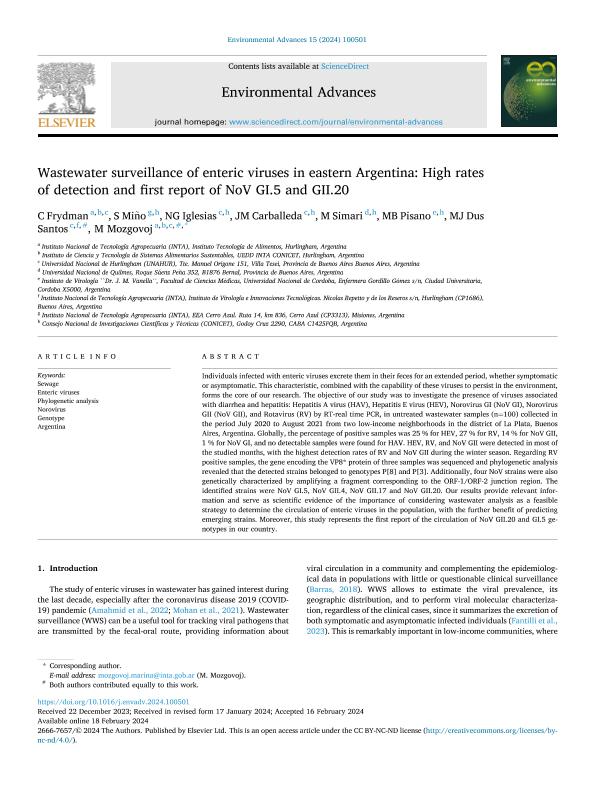Mostrar el registro sencillo del ítem
dc.contributor.author
Frydman, Camila Ayelen

dc.contributor.author
Miño, S.
dc.contributor.author
Iglesias, N. G.
dc.contributor.author
Carballeda, J. M.
dc.contributor.author
Simari, Milagros Belén

dc.contributor.author
Pisano, María Belén

dc.contributor.author
Dus Santos, María José

dc.contributor.author
Mozgovoj, Marina Valeria

dc.date.available
2024-03-20T13:47:37Z
dc.date.issued
2024-04
dc.identifier.citation
Frydman, Camila Ayelen; Miño, S.; Iglesias, N. G.; Carballeda, J. M.; Simari, Milagros Belén; et al.; Wastewater surveillance of enteric viruses in eastern Argentina: High rates of detection and first report of NoV GI.5 and GII.20; Elsevier; Environmental Advances; 15; 4-2024; 1-10
dc.identifier.issn
2666-7657
dc.identifier.uri
http://hdl.handle.net/11336/231049
dc.description.abstract
Individuals infected with enteric viruses excrete them in their feces for an extended period, whether symptomatic or asymptomatic. This characteristic, combined with the capability of these viruses to persist in the environment, forms the core of our research. The objective of our study was to investigate the presence of viruses associated with diarrhea and hepatitis: Hepatitis A virus (HAV), Hepatitis E virus (HEV), Norovirus GI (NoV GI), Norovirus GII (NoV GII), and Rotavirus (RV) by RT-real time PCR, in untreated wastewater samples (n=100) collected in the period July 2020 to August 2021 from two low-income neighborhoods in the district of La Plata, Buenos Aires, Argentina. Globally, the percentage of positive samples was 25 % for HEV, 27 % for RV, 14 % for NoV GII, 1 % for NoV GI, and no detectable samples were found for HAV. HEV, RV, and NoV GII were detected in most of the studied months, with the highest detection rates of RV and NoV GII during the winter season. Regarding RV positive samples, the gene encoding the VP8* protein of three samples was sequenced and phylogenetic analysis revealed that the detected strains belonged to genotypes P[8] and P[3]. Additionally, four NoV strains were also genetically characterized by amplifying a fragment corresponding to the ORF-1/ORF-2 junction region. The identified strains were NoV GI.5, NoV GII.4, NoV GII.17 and NoV GII.20. Our results provide relevant information and serve as scientific evidence of the importance of considering wastewater analysis as a feasible strategy to determine the circulation of enteric viruses in the population, with the further benefit of predicting emerging strains. Moreover, this study represents the first report of the circulation of NoV GII.20 and GI.5 genotypes in our country.
dc.format
application/pdf
dc.language.iso
eng
dc.publisher
Elsevier

dc.rights
info:eu-repo/semantics/openAccess
dc.rights.uri
https://creativecommons.org/licenses/by-nc-nd/2.5/ar/
dc.subject
SEWAGE
dc.subject
ENTERICVIRUSES
dc.subject
PHYLOGENETIC ANALYSIS
dc.subject
NOROVIRUS
dc.subject.classification
Otras Ciencias Naturales y Exactas

dc.subject.classification
Otras Ciencias Naturales y Exactas

dc.subject.classification
CIENCIAS NATURALES Y EXACTAS

dc.title
Wastewater surveillance of enteric viruses in eastern Argentina: High rates of detection and first report of NoV GI.5 and GII.20
dc.type
info:eu-repo/semantics/article
dc.type
info:ar-repo/semantics/artículo
dc.type
info:eu-repo/semantics/publishedVersion
dc.date.updated
2024-03-15T11:33:25Z
dc.journal.volume
15
dc.journal.pagination
1-10
dc.journal.pais
Países Bajos

dc.journal.ciudad
Amsterdam
dc.description.fil
Fil: Frydman, Camila Ayelen. Instituto Nacional de Tecnología Agropecuaria. Centro de Investigación de Agroindustria. Instituto de Tecnología de Alimentos. Instituto de Ciencia y Tecnología de Sistemas Alimentarios Sustentables. - Consejo Nacional de Investigaciones Científicas y Técnicas. Oficina de Coordinación Administrativa Parque Centenario. Instituto de Ciencia y Tecnología de Sistemas Alimentarios Sustentables; Argentina. Universidad Nacional de Hurlingham.; Argentina
dc.description.fil
Fil: Miño, S.. Instituto Nacional de Tecnologia Agropecuaria. Centro Regional Misiones. Estacion Experimental Agropecuaria Cerro Azul.; Argentina
dc.description.fil
Fil: Iglesias, N. G.. Universidad Nacional de Hurlingham.; Argentina
dc.description.fil
Fil: Carballeda, J. M.. Universidad Nacional de Hurlingham.; Argentina
dc.description.fil
Fil: Simari, Milagros Belén. Consejo Nacional de Investigaciones Científicas y Técnicas; Argentina. Universidad Nacional de Quilmes; Argentina
dc.description.fil
Fil: Pisano, María Belén. Consejo Nacional de Investigaciones Científicas y Técnicas; Argentina. Universidad Nacional de Córdoba. Facultad de Medicina. Instituto de Virología Dr. J. M. Vanella; Argentina
dc.description.fil
Fil: Dus Santos, María José. Instituto Nacional de Tecnología Agropecuaria. Centro de Investigación en Ciencias Veterinarias y Agronómicas. Instituto de Virología e Innovaciones Tecnológicas. - Consejo Nacional de Investigaciones Científicas y Técnicas. Oficina de Coordinación Administrativa Parque Centenario. Instituto de Virología e Innovaciones Tecnológicas; Argentina. Universidad Nacional de Hurlingham.; Argentina
dc.description.fil
Fil: Mozgovoj, Marina Valeria. Instituto Nacional de Tecnología Agropecuaria. Centro de Investigación de Agroindustria. Instituto de Tecnología de Alimentos. Instituto de Ciencia y Tecnología de Sistemas Alimentarios Sustentables. - Consejo Nacional de Investigaciones Científicas y Técnicas. Oficina de Coordinación Administrativa Parque Centenario. Instituto de Ciencia y Tecnología de Sistemas Alimentarios Sustentables; Argentina. Universidad Nacional de Hurlingham.; Argentina
dc.journal.title
Environmental Advances
dc.relation.alternativeid
info:eu-repo/semantics/altIdentifier/url/https://linkinghub.elsevier.com/retrieve/pii/S266676572400019X
dc.relation.alternativeid
info:eu-repo/semantics/altIdentifier/doi/https://doi.org/10.1016/j.envadv.2024.100501
Archivos asociados
